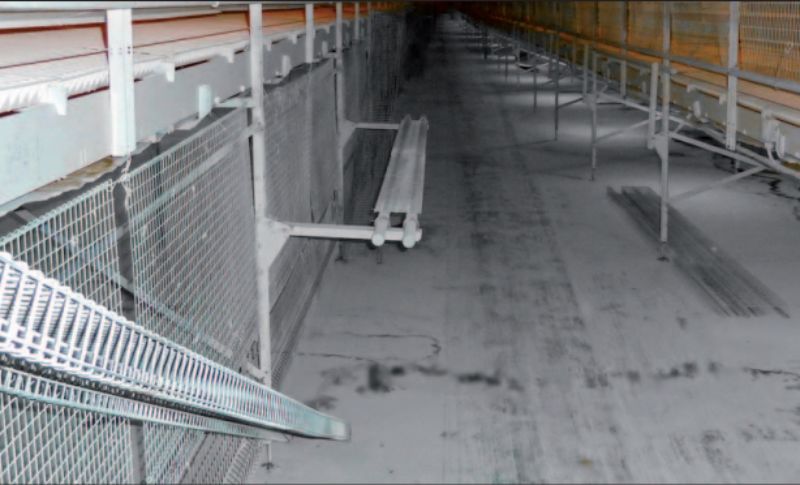Among all the poultry Ectoparasites such as fowl ticks, lice and flies, mites are considered to be the most destructive ones.
Particularly the poultry red mite (Dermanyssus Gallinae, also known as the Fowl Red Mite) has been identified as the most
harmful one for laying hens.
The title “Red” has been given to this mite as it turns from grey to red or dark red after being engorged with blood. Red mites are nocturnal (night-active) parasites which suck the birds’ blood during periods of darkness and hide themselves in all kinds of gaps and cracks during the daytime.
This behaviour makes the treatment of red mites harder and more complicated than other mite species like the northern fowl mite (Ornithonyssus sylviarum). Unlike the red mite, the northern fowl mite spends its entire life attached to its host. As such, treatment should only be applied directly on the birds. On the other hand, the red mite is able to survive long periods of time in the surroundings without being on the host bird and without even having a single meal of blood. This means that any treatment against fowl red mite must be applied on the birds as well as within the house and on the equipment. This implies that even after the removal of the birds, the poultry house will remain infested for a long time, i.e. if no appropriate treatment would be applied. Furthermore, the long period of egg production allows for red mites to create large populations and cause heavy infestation in poultry farms.
Under favourable conditions (i.e. within ambient temperatures of between 25 – 30 ˚C and a relative humidity of 60 – 70 %), the life cycle of a red mite from an egg to an adult, can be completed within 7 – 14 days.
Fowl red mites are spread almost worldwide. Especially farmers in Europe, the Middle East and Asia do not only suffer from production losses but are also confronted with health as well as financial damages caused by the infestation of these mites. The problem of its infestation and the consequences are often underestimated. Losses due to red mite infestation are estimated to be between 0.50 and 1€ per laying hen per year in Europe depending on housing system, infestation intensity and control methods.
Treatments against poultry red mite
The methods of controlling red mite can be divided into applications of conventional chemicals and alternative solutions.
Conventional treatments:
Synthetic acaricides such as Organo Phosphates, Carbomates, Pyrethroids are the most common chemicals used against mite infestations, although it must be mentioned that due to some problems, their efficiency and the success of their application are getting to be more questionable. Developing resistance against acaricides caused by red mite populations has been ongoing for years now which might make treatment almost ineffective. Furthermore, wrong dosage and improper application of an acaricide can also accelerate the process of resistance development. Using higher dosages of pesticide is also a risk for the health of birds and consumers due to possible residues which might be found in eggs and meat. On the other hand, constant changes in legislations in respective countries and a very limited number of pesticides licensed against red mite, make the situation even harder for farmers to control this pest.

Alternative treatments:
In order to tackle the abovementioned problems and other hindrances in the use of conventional chemicals and pesticides against poultry red mite, new alternative solutions were developed in recent years. It is well-known that “Essential oils” derived from plants such as garlic, neem tree, thyme and tea have a toxic effect against red mites. Based on this fact, various products in forms of drinking and feeding additives are available on the market. Side effects such as tainting eggs may occur whilst using these products.
“Biological pesticides” such as Spinosad which has been used against mites of agricultural crops for several years now, also have a good reputation for controlling poultry mites. Spinosad is a natural product based on the fermentation of the bacteria S.Spinosa. Proper application is essential for a successful treatment.
Using so-called “Predator mites” is another rather new method of controlling red mites. As a natural enemy, the predator mite is able to combat and eat poultry red mites. Choosing the correct predator candidates in addition to proper management are essential for this method of control.
Based on the fact that temperatures above 45 °C are considered as lethal for poultry red mites, “Heat treatments” have been practiced lately in European countries. Heating up the poultry house to up to 60 °C for about 2 hours or 45 °C for a longer time after birds are removed, are common models of this treatment. The fusibility of plastic parts of the equipment must be considered and treatment should be performed by experts with great caution. “Low temperature treatments” with liquid nitrogen and dry ice have also been experimented on. These methods are too expensive and still need to be developed for common practice.
Special “Intermittent lighting programs” are also tools to control red mites and this is being practiced mainly in Middle Eastern and African countries. Negative effects on feed consumption, laying performance and disturbance of circadian rhythm can be expected. However, the European bird welfare legislation forbids such lighting regimes.
An example of a very common treatment against poultry red mite in Germany and the Netherlands is the use of “Inert dusts”, a physical treatment based on Silicon Dioxide compounds which blocks the joints between chitin shell and causes the immobilisation of mites. Furthermore, silicate dust enters the respiratory system of the red mites causing suffocation. Choosing the proper product, mixture, particle size, pressure and appropriate application are crucial for a successful treatment. On the other hand, application of inert dusts in poultry houses causes stress and health problems for birds and staff. The impact and side effects of this treatment should be further investigated.

Apply a treatment as soon as the first mites have been detected and before the mite population increases. (A heavy infestation of fowl red mites in a poultry house, Photo: Farhad Mozafar / LTZ)
The development of “Vaccines” is also another alternative solution in controlling the populations of poultry mites. There are different research groups which are working on identifications and characterisation of possible antigens against red mites. If such vaccines can be successfully developed, the first candidates for a commercial vaccine against poultry red mites might just be available in the near future.
General Recommendations
Some simple basic tools besides biosecurity measures and hygiene management issues can be very useful in controlling the infestation of red mites. Some of these are as follows:
• Find an effective and individual concept, e.g. the combination of different treatments suitable for your farm and housing system.
• Give mites little or no possibility to hide themselves in equipment and in the building of your farm.
• Use monitoring tools like mite traps to start a treatment as soon as the first mites have been detected and before the mite population increases.
• Apply treatment directly after the removal of the birds and before the mites get a chance to hide themselves in cracks and crevices.
• The use of an effective insecticide against red mite eggs is highly recommended since many treatments do not show efficiency against mite eggs.
• Prevent the occurrence of red mite reinfestation in your farm (from rearing, construction of houses, transport vehicles, staff, visitors, wild birds etc.)
Conclusion
Unfortunately, the current treatment methods which are available are not effective enough to keep red mite infestation under control in many poultry farms worldwide. The ban of conventional cages in Europe and keeping more laying hens in alternative systems like free-range which is, by the way, favoured by red mites, make the situation even more difficult. These kinds of systems give mites more hiding possibilities and they can therefore escape control methods more easily. Hence, there is still a great demand in developing more useful effective treatments such as vaccines to keep red mite infestations under control. However, controlling red mite population still remains a very big challenge in the keeping of laying hens.
Farhad Mozafar
Technical Service
 Choosing the proper product, mixture, particle size, pressure and appropriate application are crucial for a successful treatment with inert
dusts. The impact and side effects of this treatment on birds and humans should be further investigated. (A poultry house after Silicate
dust treatment, Photo: Farhad Mozafar / LTZ)
Choosing the proper product, mixture, particle size, pressure and appropriate application are crucial for a successful treatment with inert
dusts. The impact and side effects of this treatment on birds and humans should be further investigated. (A poultry house after Silicate
dust treatment, Photo: Farhad Mozafar / LTZ)

Use tools like adhesive mite traps or cardboards to monitor infestation intensity in your farm (different kinds of red mite monitoring tools, Photo: Farhad Mozafar / LTZ)
The title “Red” has been given to this mite as it turns from grey to red or dark red after being engorged with blood. Red mites are nocturnal (night-active) parasites which suck the birds’ blood during periods of darkness and hide themselves in all kinds of gaps and cracks during the daytime.
This behaviour makes the treatment of red mites harder and more complicated than other mite species like the northern fowl mite (Ornithonyssus sylviarum). Unlike the red mite, the northern fowl mite spends its entire life attached to its host. As such, treatment should only be applied directly on the birds. On the other hand, the red mite is able to survive long periods of time in the surroundings without being on the host bird and without even having a single meal of blood. This means that any treatment against fowl red mite must be applied on the birds as well as within the house and on the equipment. This implies that even after the removal of the birds, the poultry house will remain infested for a long time, i.e. if no appropriate treatment would be applied. Furthermore, the long period of egg production allows for red mites to create large populations and cause heavy infestation in poultry farms.
Under favourable conditions (i.e. within ambient temperatures of between 25 – 30 ˚C and a relative humidity of 60 – 70 %), the life cycle of a red mite from an egg to an adult, can be completed within 7 – 14 days.
Fowl red mites are spread almost worldwide. Especially farmers in Europe, the Middle East and Asia do not only suffer from production losses but are also confronted with health as well as financial damages caused by the infestation of these mites. The problem of its infestation and the consequences are often underestimated. Losses due to red mite infestation are estimated to be between 0.50 and 1€ per laying hen per year in Europe depending on housing system, infestation intensity and control methods.
Treatments against poultry red mite
The methods of controlling red mite can be divided into applications of conventional chemicals and alternative solutions.
Conventional treatments:
Synthetic acaricides such as Organo Phosphates, Carbomates, Pyrethroids are the most common chemicals used against mite infestations, although it must be mentioned that due to some problems, their efficiency and the success of their application are getting to be more questionable. Developing resistance against acaricides caused by red mite populations has been ongoing for years now which might make treatment almost ineffective. Furthermore, wrong dosage and improper application of an acaricide can also accelerate the process of resistance development. Using higher dosages of pesticide is also a risk for the health of birds and consumers due to possible residues which might be found in eggs and meat. On the other hand, constant changes in legislations in respective countries and a very limited number of pesticides licensed against red mite, make the situation even harder for farmers to control this pest.

Alternative treatments:
In order to tackle the abovementioned problems and other hindrances in the use of conventional chemicals and pesticides against poultry red mite, new alternative solutions were developed in recent years. It is well-known that “Essential oils” derived from plants such as garlic, neem tree, thyme and tea have a toxic effect against red mites. Based on this fact, various products in forms of drinking and feeding additives are available on the market. Side effects such as tainting eggs may occur whilst using these products.
“Biological pesticides” such as Spinosad which has been used against mites of agricultural crops for several years now, also have a good reputation for controlling poultry mites. Spinosad is a natural product based on the fermentation of the bacteria S.Spinosa. Proper application is essential for a successful treatment.

Using so-called “Predator mites” is another rather new method of controlling red mites. As a natural enemy, the predator mite is able to combat and eat poultry red mites. Choosing the correct predator candidates in addition to proper management are essential for this method of control.
Based on the fact that temperatures above 45 °C are considered as lethal for poultry red mites, “Heat treatments” have been practiced lately in European countries. Heating up the poultry house to up to 60 °C for about 2 hours or 45 °C for a longer time after birds are removed, are common models of this treatment. The fusibility of plastic parts of the equipment must be considered and treatment should be performed by experts with great caution. “Low temperature treatments” with liquid nitrogen and dry ice have also been experimented on. These methods are too expensive and still need to be developed for common practice.
Special “Intermittent lighting programs” are also tools to control red mites and this is being practiced mainly in Middle Eastern and African countries. Negative effects on feed consumption, laying performance and disturbance of circadian rhythm can be expected. However, the European bird welfare legislation forbids such lighting regimes.
An example of a very common treatment against poultry red mite in Germany and the Netherlands is the use of “Inert dusts”, a physical treatment based on Silicon Dioxide compounds which blocks the joints between chitin shell and causes the immobilisation of mites. Furthermore, silicate dust enters the respiratory system of the red mites causing suffocation. Choosing the proper product, mixture, particle size, pressure and appropriate application are crucial for a successful treatment. On the other hand, application of inert dusts in poultry houses causes stress and health problems for birds and staff. The impact and side effects of this treatment should be further investigated.

Apply a treatment as soon as the first mites have been detected and before the mite population increases. (A heavy infestation of fowl red mites in a poultry house, Photo: Farhad Mozafar / LTZ)
The development of “Vaccines” is also another alternative solution in controlling the populations of poultry mites. There are different research groups which are working on identifications and characterisation of possible antigens against red mites. If such vaccines can be successfully developed, the first candidates for a commercial vaccine against poultry red mites might just be available in the near future.
General Recommendations
Some simple basic tools besides biosecurity measures and hygiene management issues can be very useful in controlling the infestation of red mites. Some of these are as follows:
• Find an effective and individual concept, e.g. the combination of different treatments suitable for your farm and housing system.
• Give mites little or no possibility to hide themselves in equipment and in the building of your farm.
• Use monitoring tools like mite traps to start a treatment as soon as the first mites have been detected and before the mite population increases.
• Apply treatment directly after the removal of the birds and before the mites get a chance to hide themselves in cracks and crevices.
• The use of an effective insecticide against red mite eggs is highly recommended since many treatments do not show efficiency against mite eggs.
• Prevent the occurrence of red mite reinfestation in your farm (from rearing, construction of houses, transport vehicles, staff, visitors, wild birds etc.)
Conclusion
Unfortunately, the current treatment methods which are available are not effective enough to keep red mite infestation under control in many poultry farms worldwide. The ban of conventional cages in Europe and keeping more laying hens in alternative systems like free-range which is, by the way, favoured by red mites, make the situation even more difficult. These kinds of systems give mites more hiding possibilities and they can therefore escape control methods more easily. Hence, there is still a great demand in developing more useful effective treatments such as vaccines to keep red mite infestations under control. However, controlling red mite population still remains a very big challenge in the keeping of laying hens.
Farhad Mozafar
Technical Service
 Choosing the proper product, mixture, particle size, pressure and appropriate application are crucial for a successful treatment with inert
dusts. The impact and side effects of this treatment on birds and humans should be further investigated. (A poultry house after Silicate
dust treatment, Photo: Farhad Mozafar / LTZ)
Choosing the proper product, mixture, particle size, pressure and appropriate application are crucial for a successful treatment with inert
dusts. The impact and side effects of this treatment on birds and humans should be further investigated. (A poultry house after Silicate
dust treatment, Photo: Farhad Mozafar / LTZ)

Use tools like adhesive mite traps or cardboards to monitor infestation intensity in your farm (different kinds of red mite monitoring tools, Photo: Farhad Mozafar / LTZ)







